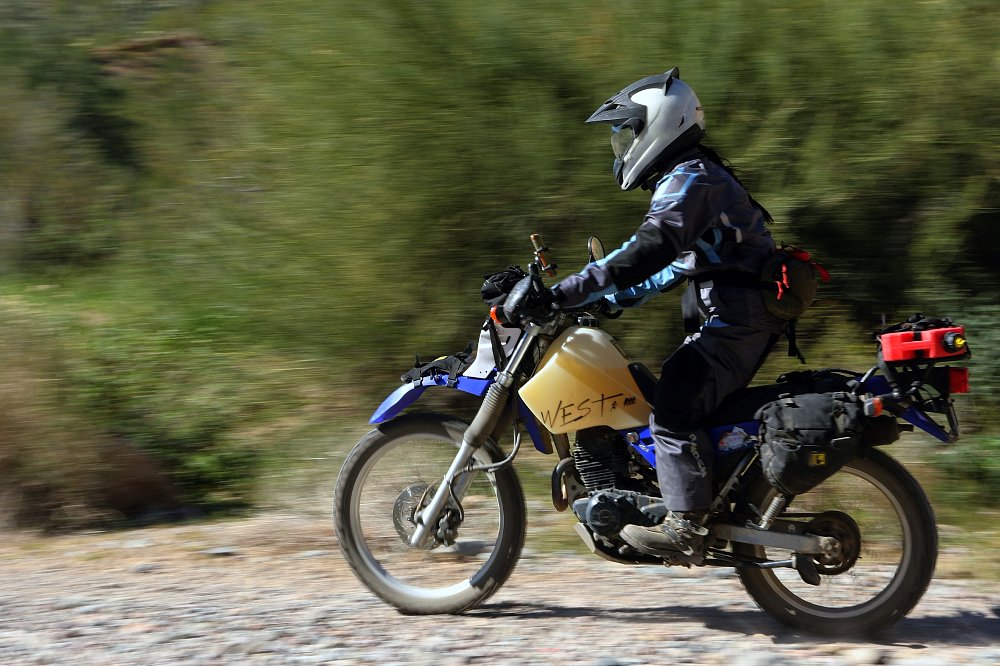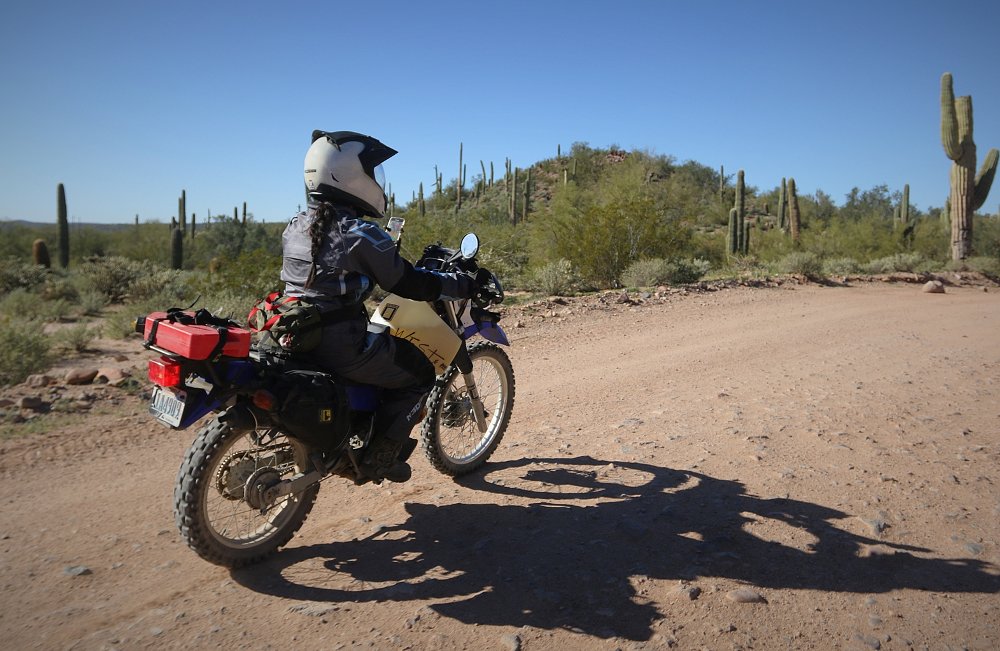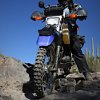The one thing all off-road motorcyclists have in common is the beginning.
Their first time throwing a leg over. That initial roar of the throttle that drew the blood out of your heart by force. The rumbling of nerves that grew louder than the engine when that tell-tale sign fast approached: “Pavement Ends.”
My first experience off the beaten path was not quite so elegant. I’d owned my XT 225 for merely a month, had it in my possession for even less. A group of familiar faces smiled and cheered as the rush boiled my cheeks red, and I continuously circled the small grassy field in a friend’s backyard. I wouldn’t even graze dirt for a few more days, but until then I learned the importance of the front and rear brakes. That, and the inevitable: crashing. Little did I know, the Earth and I were embarking on an intimate relationship. We’d visit with each other often; it wouldn’t always be pleasant; and I’d be better for it.

Whether you relate or think I’m full of it, I want to share the vital information that carried me through the last couple of years on dirt, stone, sand, mud, grass, gravel, and so much more.
Size does matter, but not how you’d think
Anyone who tells you size doesn’t matter is fooling themselves. Unlike the American motto that has shaped this vast country since Texas found the Longhorn, for the n00b, bigger is not better — relatively. Because of my five-foot, two-inch frame, I’ve been forced to find what’s best for me and not what I like best. I needed to find a bike powerful enough to handle my desired trails, but light and low so I could handle obstacles.

You may not win any style points for riding something small and basic, but what’s better than the look on your buddy’s face when you chug past him on a steep, rocky incline on a lesser bike? From someone who knows personally, it tickles that ego just right. So ride those training wheels loud and proud!
Take a class
There is a long list of off-road riding schools that teach the tricks of the trade. If I could afford to take them all, I would! I have learned a lot from friends, and a little from myself, but there’s nothing comparable to being evaluated and advised by a pro. These are people who have real hours under their tires and experience on a variety of terrain. Picking their brains is not just worth the cost of a class, it’s invaluable.
Ride your own ride
Yes, it’s easy to get carried away showing your friends just how well you ride (or want them to think you ride). Whether your level is beginner, intermediate or expert, someone will always be better and others worse. Be honest from the get-go, with your buddies but mostly with yourself. Are they soaring out of sight at light-speed? Just ask them ahead of time to wait for you at junctions or leave distinct markers so you catch up when you can. It would be best to make sure someone sticks with you in case of emergency, but the short segments between stops allows everyone to go their own pace without completely losing each other. Another point to address: If a challenge is too intimidating, it’s better to ask for help overcoming it than to have to recover your bike from the base of a cliff or visit a clinic.

Being realistic can also help you stay calm. Those who know me recognize (laugh at) the fact that a lot goes on behind my visor. During a prolonged obstacle, I sing anything from Adele to Carrie to Fleetwood Mac — whatever fills my lungs and forces me to focus on lyrics, not nerves. On a wide, loose gravel road, I relax my clenched jaw and remind myself to remove that damned lip from the grip of my teeth. It’s not hard to see how that could go wrong...
All that to say, I’ve learned to be my own coach and not my own worst enemy.
When in doubt, throttle out
The throttle is your sword. When you confront an adversary, 99 percent of the time this is the weapon that will win your battle. Deep sand, steep rocky inclines, loose gravel, all enemies of a smooth ride. So when in doubt, scan the horizon, give it gas and let the bike sort out its issues. Without momentum and speed you could sink, slip or slide into injury. If you trust your throttle, you may just make it out unscathed.

Stand, thrust and squeeze!
No, this isn’t an at-home aerobic workout by Jane Fonda. This is that Holy Grail advice that you heard someone say, but couldn’t quite execute. First, I’ll tell you what I was once told, and what I am now telling you. Stand. Really press down on your feet and make the rest of your body strong but fluid. Most obstacles can be made simpler because your weight is redirected from the tail to the front and center. This action allows your back wheel to move freely and the bike to correct itself as it wishes. If you’re going to stand, then make sure to thrust. Practicing a solid thrust every time you’re at attention ensures that your weight is forward and your body isn’t flopping around when absorbing the bump and grind of a good trail. And for the love of all that is good, squeeze that tank! Whether seated or standing, gripping the tank with your knees keeps you in control when on the brink of losing it.
Back brake, back brake, back brake
What does every motocross, Supercross, supermoto, flat track, rally raid, enduro and Endurocross racer have in common? The same thing any trail rider like myself needs to know about: the back brake. Straight lines handle a little hand squeeze, but corners call for toe, sometimes ball, even instep. It’s no revelation that too much front brake results in a flight over the handlebars. But the rear end is vital for cutting corners, descending, and just taking charge. This is short and sweet, but the phrase “put your back into it” finally means so much more.

Dirt first, second and third
What I’ve learned on gravel, stones, bedrock, water, mud, sand... has taught me miles more about riding on pavement than I ever knew before. The techniques I’ve learned on dirt transcend those on the pavement. Now, I can really handle my bike. I no longer fear the “Loose Gravel” sign or a random obstruction on the freeway.
Buy proper boots
Within the first mile on dirt during the 2014 LA-Barstow-Vegas dual-sport ride — maybe my fifth or sixth time riding off-road — I hit a 90-degree, washed-out turn too hot and far too inexperienced. The next thing I knew, 267 pounds of hot metal pinned my foot to the ground. After waiting as long as possible, we removed my mid-level boot and found my ankle bruised and swollen, but not broken. I was able to conclude my two-day trek in the Nevada backcountry. But if I had been wearing the good plastic-on-leather stuff with the shanks and the clasps and the Italian-branded sexiness, I might not still be feeling the pangs of a half-severed Achilles tendon. Better gear could have prevented that. And of course, a bit more practice.
Make your bike your best friend
Be the “Bike Whisperer.” Learn the sounds while you shift, when it’s in gear and if it sputters. Lube the chain and change its oil. Look it over before every ride and you’ll be more likely to recognize and avoid problems. Be like a Boy Scout: prepared. Pull your bike apart and put it back together again, then pack the tools that you used to make it whole. That’s what you’ll need to get yourself out of an inevitable pickle on the trail.

Selfies aren’t shameless
Do what you will on your Instagram account, but a camera, dynamic or static, is not only a way to cherish the fledgling moments of your dirt-bike relationship. It’s also a learning tool. Dancers observe their form in a mirror. Football players watch game film to see where they went wrong. And for motorcyclists, photos and video are a great way to see how you’re using your techniques or to study your lines. Even if it felt “right” at the time, referring back to those moments is a great way to understand what you were really doing and how to do it better next time.
A year and a half into this, my skills define my limits, and right now I’m at my best. But it won’t be long until I’m even better.













